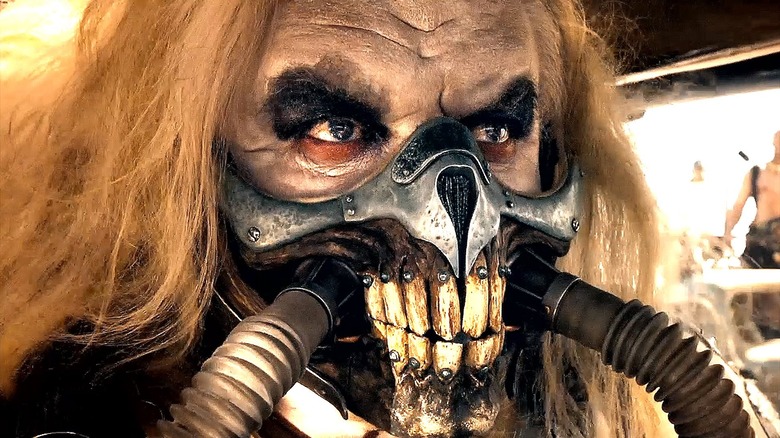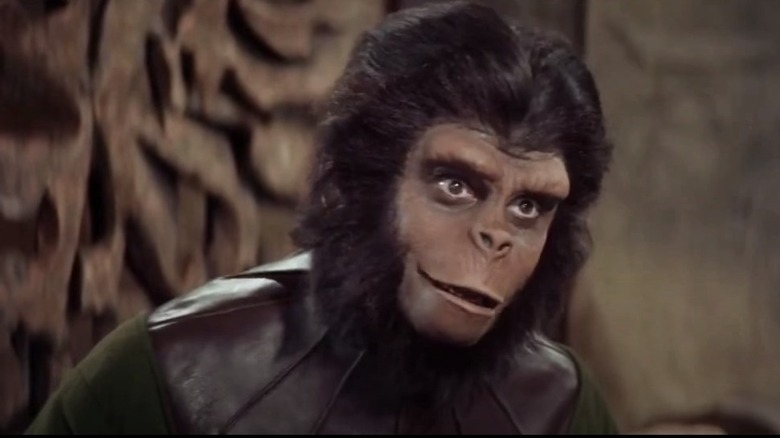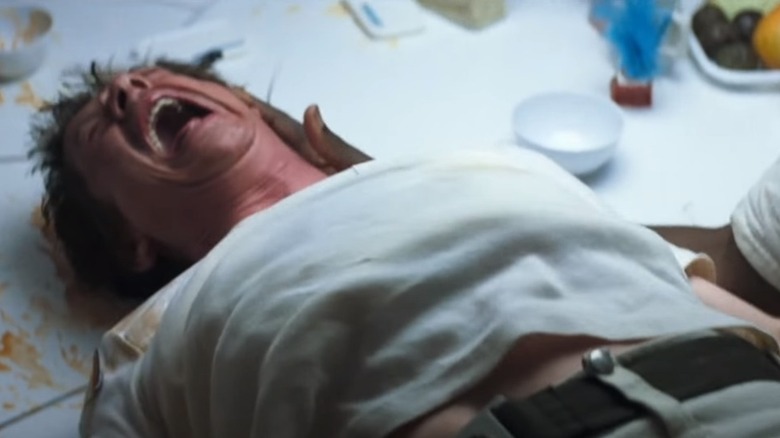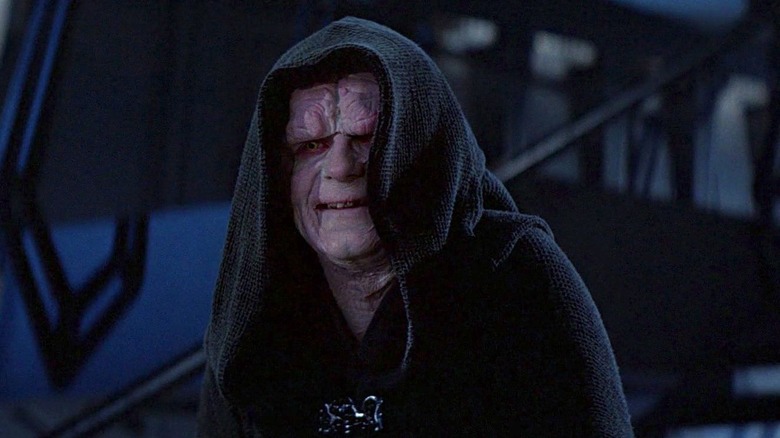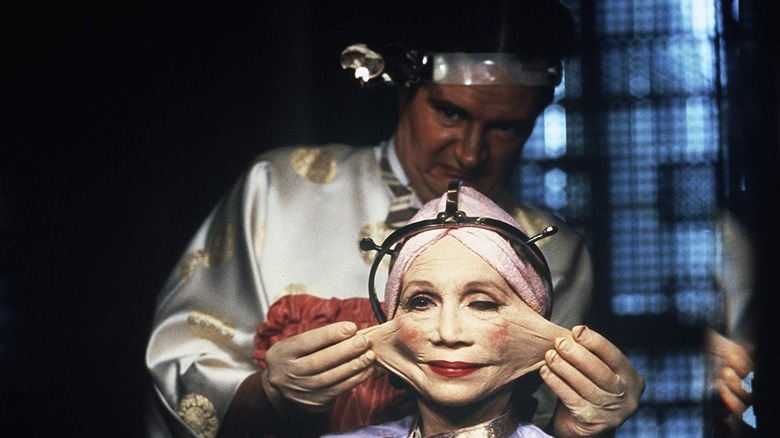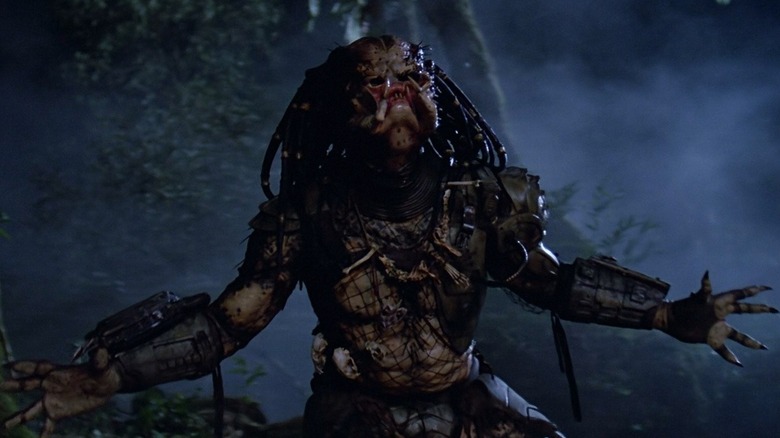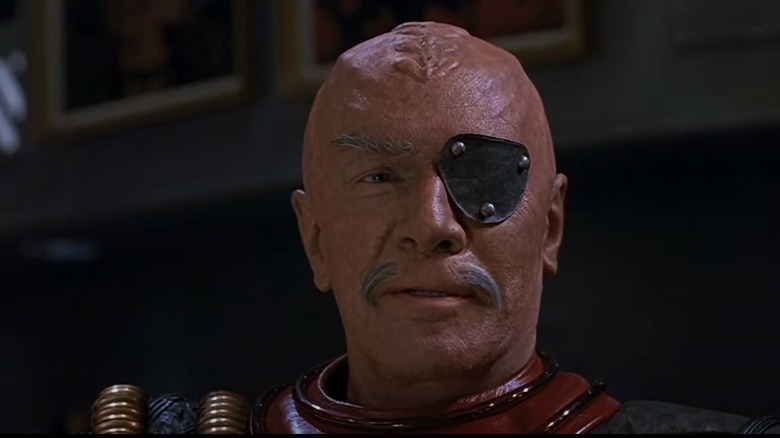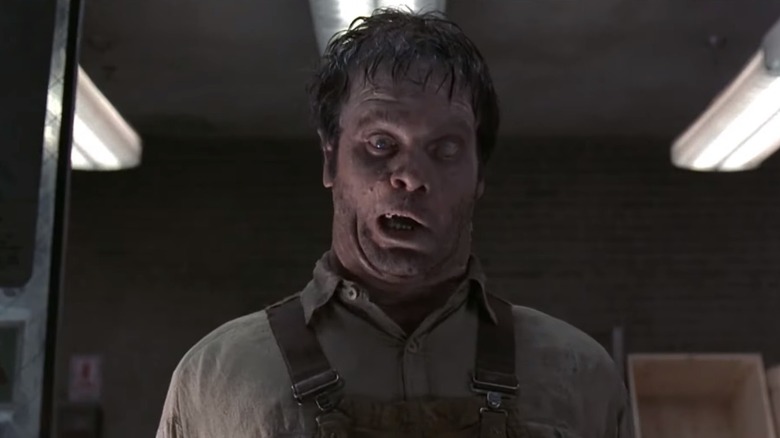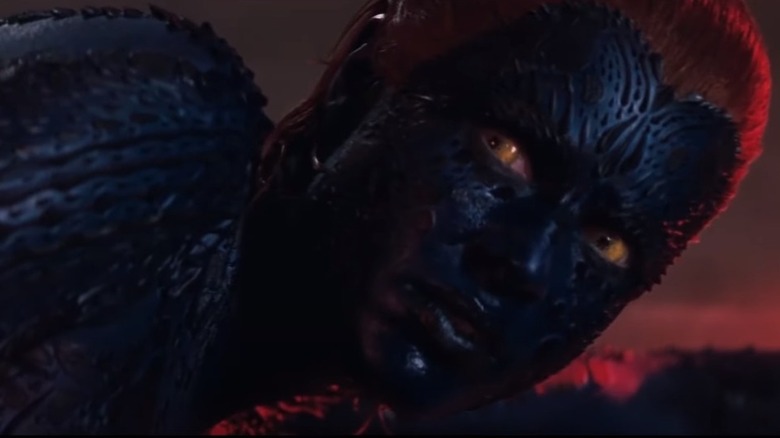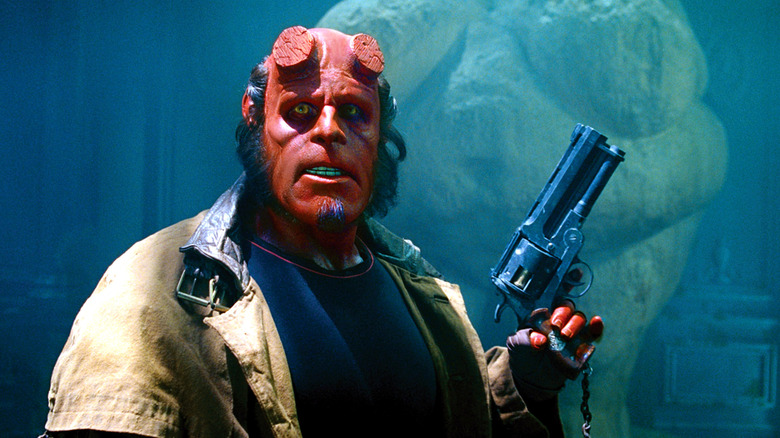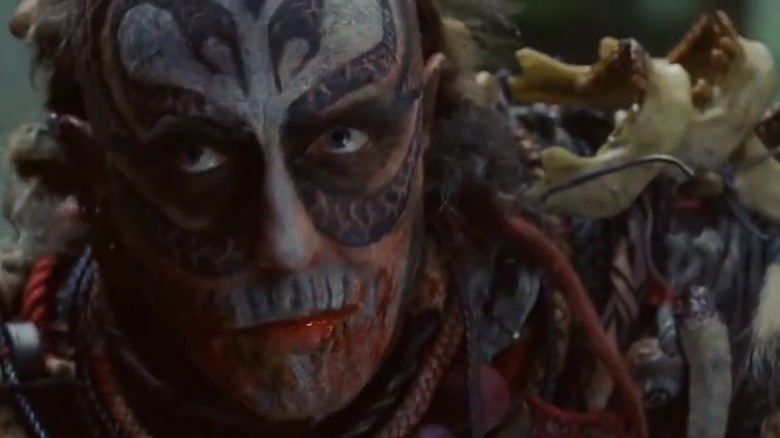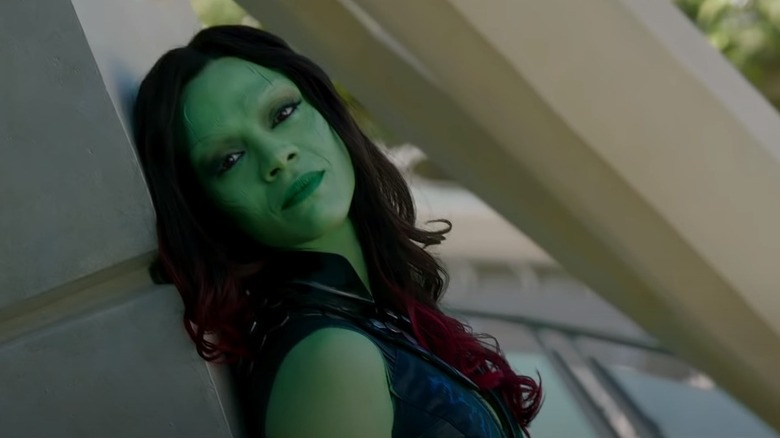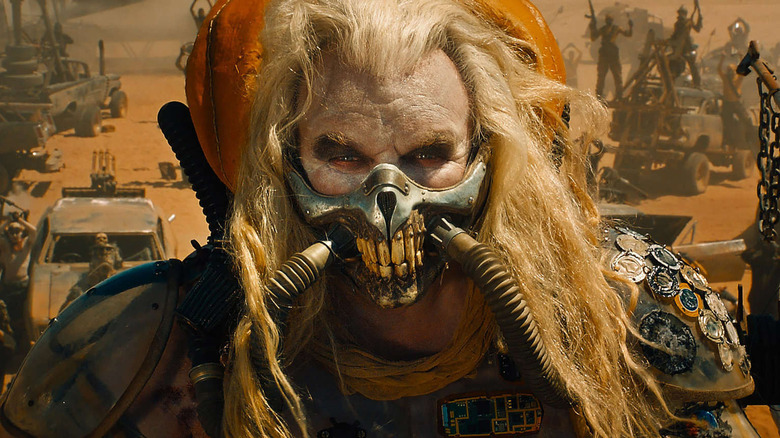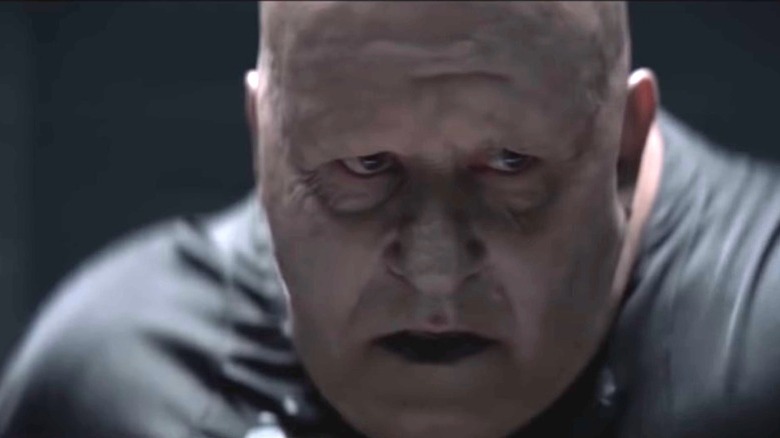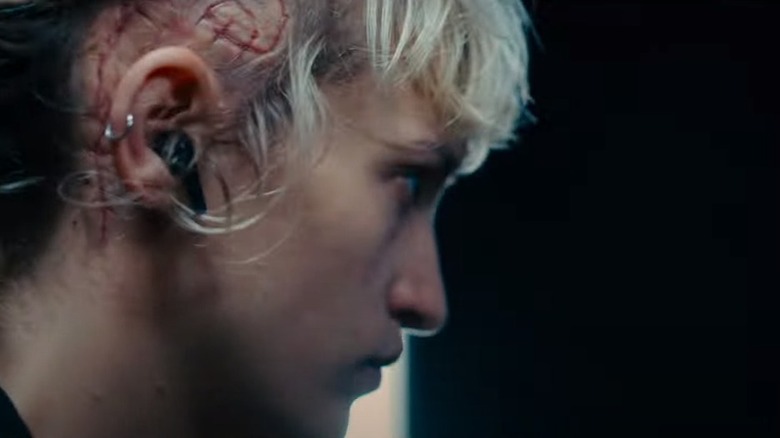The Most Impressive Sci-Fi Makeup Transformations Of All Time
Great science fiction films require viewers to take a leap of faith. The audience is being presented with concepts, characters, or worlds that they are unfamiliar with. It's up to the filmmaker to convince them they are real. The greatest sci-fi movies in history take elements of reality and reimagine them in a different context.
Sci-fi films must also be convincing on a visceral level. Many of the greatest achievements in visual effects were developed for sci-fi classics. The stop-motion animation in 1933's "King Kong," the miniature sets in "Star Wars: Episode IV- A New Hope," the computer-generated dinosaurs in "Jurassic Park," the "bullet time" action sequences in "The Matrix," and the motion-capture performance technology in "Rise of the Planet of the Apes" were game-changing accomplishments in the history of visual effects.
However, every sci-fi movie (and every movie in general) requires great characters. The amazing work of makeup artists and hairstylists has helped transform well-known actors into some of the most iconic genre characters ever. How else do you turn a comedic icon like Tim Curry into the literal devil in "Legend?" These are some of the most impressive sci-fi makeup transformations of all time.
Roddy McDowall — Planet of the Apes
Released in 1968, "Planet of the Apes" is a fascinating example of how science fiction films can be both entertaining and thought-provoking. The time travel adventure is just as entertaining to watch today as it was 50 years ago. However, the film raises interesting questions about evolution, societal roles, and the abuse of animals.
Unsurprisingly, the success of the film inspired a massive franchise. The series was revitalized by the modern reboot trilogy starring Andy Serkis. Serkis' performance as Caesar, the leader of the apes, made 2011's "Rise of the Planet of the Apes," 2014's "Dawn of the Planet of the Apes," and 2017's "War for the Planet of the Apes" some of the best blockbusters in recent memory. It even inspired 20th Century Fox to launch a legitimate awards campaign to recognize the work of motion-capture performances.
However, Serkis' performance wouldn't have been possible if it wasn't for the amazing makeup work in the original film. Legendary makeup artist John Chambers used extensive prosthetics to transform Roddy McDowall into Cornelius, an intelligent ape scientist who shows compassion to George Taylor (Charlton Heston). McDowall could have looked ridiculous, but Cornelius is the heart of the film.
John Hurt — Alien
Ridley Scott's 1979 science fiction classic, "Alien," has one of the greatest logline pitches in motion picture history: "What if you set 'Jaws' in space?" Outer space horror movies were not a new concept, but Scott understood that true horror was about more than just blood and gore. The Xenomorph alien became an icon of pop culture, but it lurks in the shadows for the majority of the original film. It's what Scott doesn't show that makes "Alien" so terrifying. The crew of the "Nostromo" doesn't understand what the mysterious creature is capable of until it's too late.
Early in the film, a face-hugger (an early stage in the xenomorph life cycle) attaches itself to the face of Executive Officer Kane (John Hurt). Although the face-hugger dies, the stakes are immediately raised when the Xenomorph bursts through Kane's chest, killing him.
This moment of true body horror is one of the most terrifying sequences in the entire "Alien" franchise. It's important to the tone of the film. The heroes of "Alien" are simply working-class people who have no experience dealing with extraterrestrial monsters. Scott got the cast's legitimate reactions to the chest-burster sequence by not revealing the effect until the scene was shot.
Ian McDiarmid — Return of the Jedi
"Return of the Jedi" marked the culmination of the original "Star Wars" trilogy and the final confrontation between Luke Skywalker (Mark Hamill) and his father, Darth Vader (David Prowse). Although Emperor Palpatine (Ian McDiarmid) hadn't yet appeared on screen in full, his influence was strong in the first two films. Palpatine only briefly appears as a holographic projection in "The Empire Strike Back," but it's clear that he is the one character that holds power over Vader.
"Return of the Jedi" had to show that Palpatine holds authority over Vader. This wasn't an easy task. Vader had already become one of the most iconic villains in film history. Instead of making Palpatine a ruthless warrior like his apprentice, George Lucas chose to turn the Dark Lord of the Sith into a sickly old man. The prosthetics work on Ian McDiarmid's face implies an entire history that is never directly spelled out to the viewers. Palpatine is scarred, deformed, and weakened by his many evil actions. McDiarmid, a young British stage actor at the time, is completely unrecognizable.
While Vader hides his scars from the Imperial Officers, Palpatine relishes his own off-putting appearance. The frail nature of Palpatine's body throws Luke off guard. After Luke refuses to kill Vader, Palpatine stands up, showing that he has no need for a walking stick. The electrocution scene wouldn't have been effective if Palpatine hadn't initially seemed so sickly.
Katherine Helmond — Brazil
When director Terry Gilliam offered Katherine Helmond the role of Mr. Ida Lowry in his 1985 film, "Brazil," he said, "You're not going to look very nice in it." Gilliam hand-picked Helmond for the part. She had extensive experience working on television sitcoms, and Gilliam knew that she could capture the unique satirical tone that he was going for. "Brazil" is more than a standard dystopian mystery. It's an absurd yet terrifying exploration of the corrupting nature of corporate greed and an over-reliance on technology.
Helmond portrays the mother of Jonathan Pryce's character, Sam. While Sam has begun to question his role in society, Ida wallows in her indulgences. During one of the most awkwardly disturbing moments in the film, Ida undergoes extensive plastic surgery that stretches out her face. While it's an absurd exaggeration of de-aging practices, the scene feels authentic due to the excellent makeup effects applied by Gilliam's wife, Maggie. Helmond had to undergo ten hours of preparation for the makeup to be applied.
Jeff Goldblum — The Fly
David Cronenberg's 1986 horror film, "The Fly," is one of the greatest remakes of all time. The original film from 1958 is a schlocky "creature feature" that focuses more on shocking thrills than on character development. While the original film is an enjoyable product of its era, Cronenberg reimagined the story as a romantic tragedy. The lead character, Seth Brundle (Jeff Goldblum), is very sympathetic. Seth makes a scientific breakthrough by inventing a viable teleportation device.
Despite his eccentricities, Seth isn't some crazy "mad scientist." He's genuinely excited about his research and seeks to woo journalist Ronnie Quaife (Geena Davis). The delightful chemistry between Seth and Ronnie makes the tragic direction of the story even more heartbreaking. Hoping to impress Ronnie, Seth places himself in the teleportation device, not realizing that a fly has also crept into the machine. Seth's body begins to transform as he slowly adopts fly-like qualities.
The incredible makeup and prosthetics work from Chris Walas and Stephan Dupuis shows the gradual decline of Seth's physicality in conjunction with his transformation. None of the changes to his body happen overnight. He slowly begins to feel more energetic and develops an insatiable craving for sugar. Walas and Dupuis won an Academy Award for their incredible character designs.
Kevin Peter Hall — Predator
John McTiernan's 1987 classic, "Predator," may be a science fiction film, but the jungle setting is reminiscent of Vietnam war films. McTiernan approached the concept of an extraterrestrial invader with a surprising sense of grittiness. The film follows a paramilitary rescue operation in the Central American rainforest. Maj. Dutch Schaefer (Arnold Schwarzenegger) leads a team to rescue a group of hostages held by guerilla soldiers.
In the opening scenes, "Predator" does not immediately announce that it is a sci-fi film. It's only after the fearsome Predator (Kevin Peter Hall) starts picking off the commandos that Dutch realizes they're not facing an ordinary enemy. However, the film would have lost its intensity if the monster that Dutch and his men were facing was just a goofy special effect. Having Kevin Peter Hall transform into the alien creature made the combat sequences more exciting. Schwarzeneggar and the other cast members got to do actual stunt choreography, and not just act against a completely digital creature.
McTiernan enlisted the brilliant makeup designer Stan Winston to design a prosthetic suit. Having full-body makeup did not make Hall's shooting experience very pleasant. He replaced Jean Claude Van Damme in the title role, as Van Damme had complained that the suit was too hot. However, Hall did the role justice, and the result is some of the most intense action sequences ever created.
Christopher Plummer — Star Trek VI: The Undiscovered Country
The "Star Trek" franchise has no shortage of iconic alien creatures. Even if you've never seen an episode of the original series, you are probably familiar with alien races like the Vulcans, Romulans, Klingons, Cardassians, Ferengi, and the Borg. 1991's "Star Trek VI: The Undiscovered Country" completely changed the way that the Klingons were portrayed on screen.
Makeup artists Richard Snell, Michael Mills, and Ed French upgraded the Klingon prosthetics to make them more expressive. "The Undiscovered Country" delves deeper into the Klingon culture than any of the previous films. There are more Klingon characters in "The Undiscovered Country" than in all five of the previous films combined. The film revolves around a peace treaty between the Klingon Empire and the Federation. James T. Kirk (William Shatner) and Spock (Leonard Nimoy) negotiate with the Klingon council.
Of all the Klingons in the film, Christopher Plummer's character, Chang, is the most memorable. Chang is a remorseless military leader who stages a plot to frame Kirk for the assassination of the Klingon Chancellor. Plummer brought elegance to the role. Chang often quotes Shakespeare and brags to Kirk about his knowledge of the arts. This would have seemed completely ridiculous without good prosthetics. Snell, Mills, and French received an Academy Award nomination for best makeup for their work.
Vincent D'Onofrio — Men in Black
The 1997 science fiction film "Men in Black" has a brilliant premise. What if aliens were living among us? Based on the comic book series of the same name, "Men in Black" imagines a world where aliens disguise themselves on Earth. The mysterious government agency known as the "Men in Black" monitors these extraterrestrial visitors, and wipes the memories of any human who happens to see them.
"Men in Black" created a vast world, featuring many different alien creatures. Makeup artists Rick Baker and David LeRoy Anderson were tasked with populating background environments that featured countless different species. While many of these characters are comedic, the "Bug" character was completely terrifying. The bug-like creature inhabits the body of the farmer Edgar (Vincent D'Onofrio). In the Blu-Ray release of the film, Baker cited the film as the most challenging shoot of his career. D'Onofrio's delivers an offbeat performance as a creature that is trying, but failing, to seem human.
Rebecca Romijn — X-Men
The original 2000 "X-Men" film changed the course of comic book movie history forever. Instead of treating its characters like cartoons, "X-Men" took a more serious tone. The mutant characters face discrimination from mankind. Magneto's chief lieutenant, Mystique (Rebecca Romijn), can transform herself and mimic other characters. Mystique is uncomfortable in her skin.
Unfortunately, the process was just as uncomfortable for Romijn. She went through a grueling nine-hour process to have Mystique's skin applied to her own. Despite the challenges, Romijn said that "every single time they finished, and I would look in the mirror, I would just look at it like it was a masterpiece." The makeup department worked hand-in-hand with the visual effects crew to create the sequences in which Mystique turns into Bobby Drake (Shawn Ashmore) and Wolverine (Hugh Jackman).
Romijn created the definitive version of Mystique. When Jennifer Lawrence was cast as a young Mystique in "X-Men: First Class," she underwent a similar makeup procedure.
Ron Perlman — Hellboy
There aren't a lot of modern filmmakers who know how to seamlessly combine makeup and visual effects. However, Guillermo del Toro is one of them. All of Del Toro's films feature outstanding creature designs that embellish the stories with personality. Del Toro was the ideal choice to bring Mike Mignola's character "Hellboy" to the big screen. The "Hellboy" stories incorporate elements of horror, fantasy, and romance. These are all genres that Del Toro is more than familiar with.
Del Toro cast one of his favorite collaborators, Ron Perlman, in the title role as the demon antihero. In the director's commentary for the 2019 Blu-Ray release, Del Toro said that he cast Perlman because of his familiarity with prosthetics work. Perlman made Hellboy both scary and sympathetic, and he set a high bar for future adaptations. The critically-derided 2019 remake starring David Harbor failed to live up to the precedent that Perlman and Del Toro established.
Hugh Grant — Cloud Atlas
Famed film critic Roger Ebert cited "Cloud Atlas" as "one of the most ambitious films ever made." The epic adaptation of David Mitchell's 2004 novel of the same name takes place over six different points in human history. To show how the same stories are repeated throughout time, the creative team of Lana Wachowski and Lilly Wachowsk cast the same group of actors in multiple roles.
Hugh Grant appears as six different characters in each era. He appears as the Southern plantation manager, Giles Horrox, in 1849, a nameless hotel employee in 1936, the nuclear plant developer, Lloyd Hooks, in 1973, the brother of Jim Broadbent in 2012, a restaurant owner in 2144, and a cannibalistic tribesman in the dystopian future of 2321. Before "Cloud Atlas," Grant was best known for his work in romantic comedies in the 1990s. He said that he was excited by the opportunity to transform into evil characters — specifically the tattooed cannibal leader.
Zoe Saldana — Guardians of the Galaxy
"Guardians of the Galaxy" was not the first time that Zoe Saldana played an unrecognizable alien character. She famously appeared as Neytiri in James Cameron's science fiction epic, "Avatar." However, the two roles are very different. Saldana must wear full body makeup to play the alien assassin, Gamora. Saldana has said that she enjoys playing these types of roles because she finds "the escape to be much more rewarding." The film earned an Academy Award nomination for best makeup and hairstyling, which was a first for the Marvel Cinematic Universe.
Unlike Neytiri, Gamora is not a traditional hero. She is one of the top assassins for her adopted father, Thanos (Josh Brolin). Although Gamora was trained to be a killer, she suffered abuse at the hands of her father and learns to rebel against him. Gamora has never been shown true affection, and Peter Quill's (Chris Pratt) flirtations catch her off guard.
Hugh Keays-Byrne — Mad Max: Fury Road
"Mad Max: Fury Road" from 2015 was not the first time that Hugh Keays-Byrne appeared in George Miller's post-apocalyptic action franchise. He co-starred as the villain Toecutter in the original "Mad Max" in 1979. However, Keays-Byrne returned to the series to play the fearsome warlord Immortan Joe, who controls the water supply in the wasteland. Immortan Joe enslaves young girls to be his wives, and demands loyalty from his fanatic "war boys."
The makeup team designed Immortan Joe's signature look to hint at a violent history that is never completely spelled out to the audience. While we don't know much about Joe's backstory, it's clear that he's earned a reputation for his brutality through many years of conquest. "Mad Max: Fury Road" is a commentary on gender roles and female empowerment. The grotesque design of Immortan Joe is the ultimate personification of toxic masculinity.
Stellan Skarsgård — Dune
While David Lynch's 1984 adaptation of "Dune" has its merits, good makeup design is not one of them. The grotesque design of the Harkonnen characters in Lynch's version is laughable and not scary or menacing at all. Denis Villeneuve seriously upgraded the design of the villains for his 2021 adaptation of Frank Herbert's novel. Stellan Skarsgård is completely unrecognizable as the ruthless Baron Vladimir Harkonnen.
Skarsgård spent over 80 hours in makeup to prepare for the part. He wanted the Baron to be a frightening presence "even if he doesn't say anything." Although some actors may have been hesitant about spending so much time in extensive makeup, Skarsgård was enthusiastic about the process. "Dune's" makeup artist, Donald Mowat, said that Skarsgård "begged" to have more scenes in which the Baron was naked. Skarsgård felt that the character would be even more terrifying when he was unclothed.
Agathe Rousselle — Titane
If you haven't seen the French body horror film, "Titane," you're missing out on one of the craziest and most delightfully absurd arthouse films of the past decade. The film stars Agathe Rousselle as Alexia, a child who suffers a skull injury in a car accident. During surgery, Alexia has a titanium plate inserted within her head. To say anything more would be revealing too much, but "Titane" goes on to explore how sexuality, identity, object fetishism, and trauma are all intertwined. Even lifelong horror movie fans may be surprised by how graphic the film gets with its shockingly violent and sexual content.
Given Alexia's tragic backstory, Rouselle had to channel a very emotional performance. She said that the support from the makeup team made her more enthusiastic about the part. Rouselle spent over eight hours with the makeup department every day and said that the preparation time helped her decompress between the emotional scenes.
